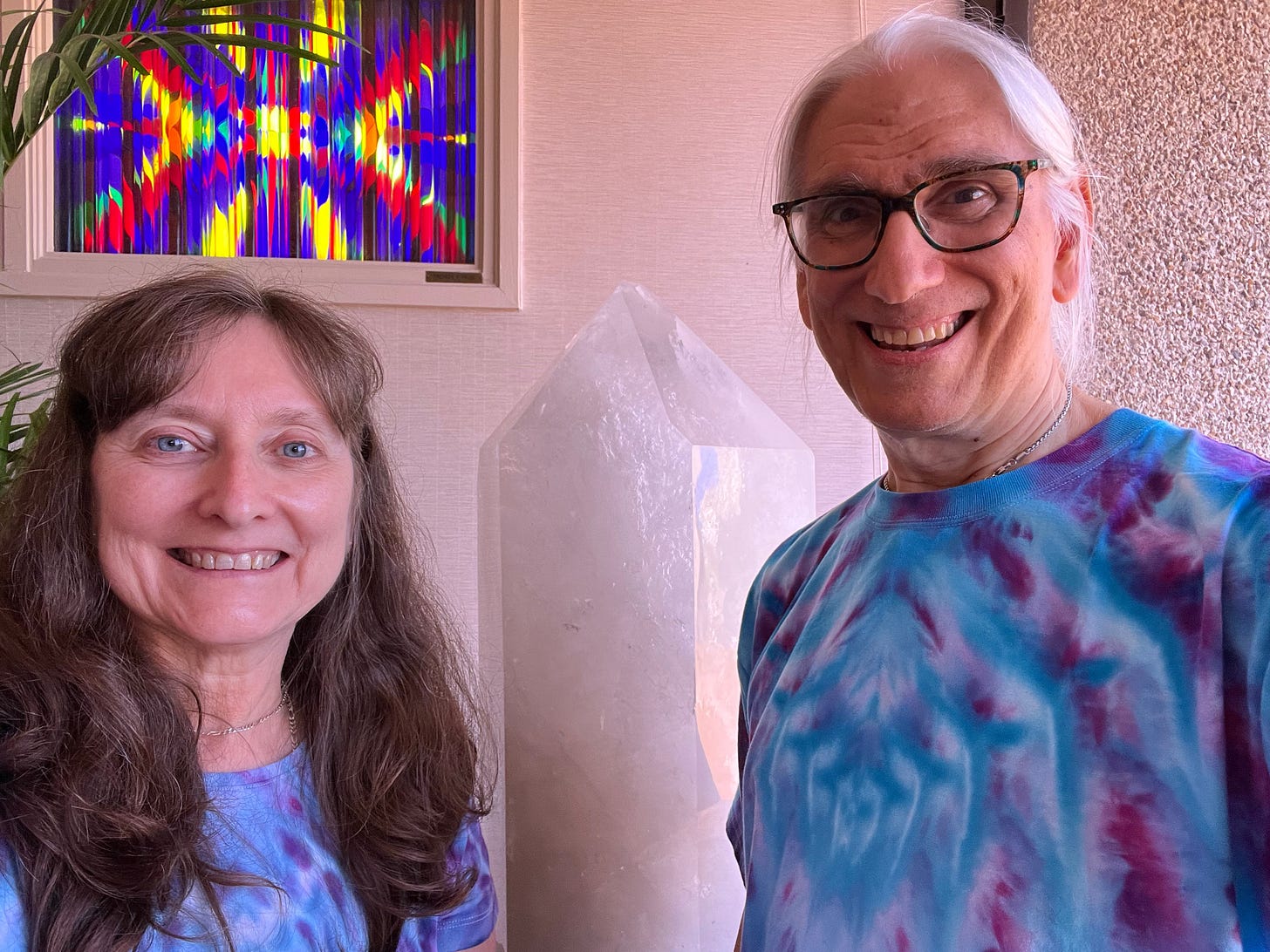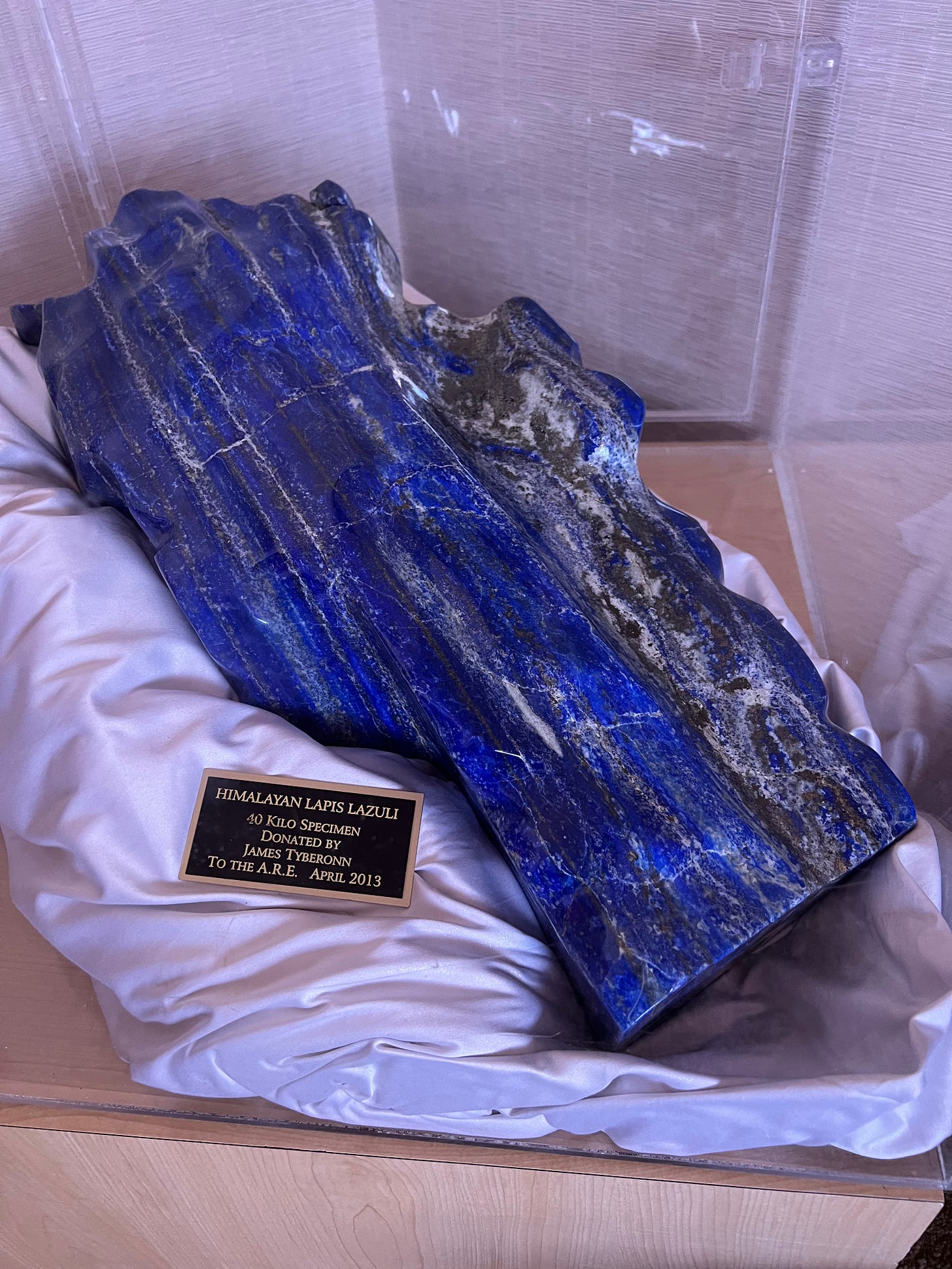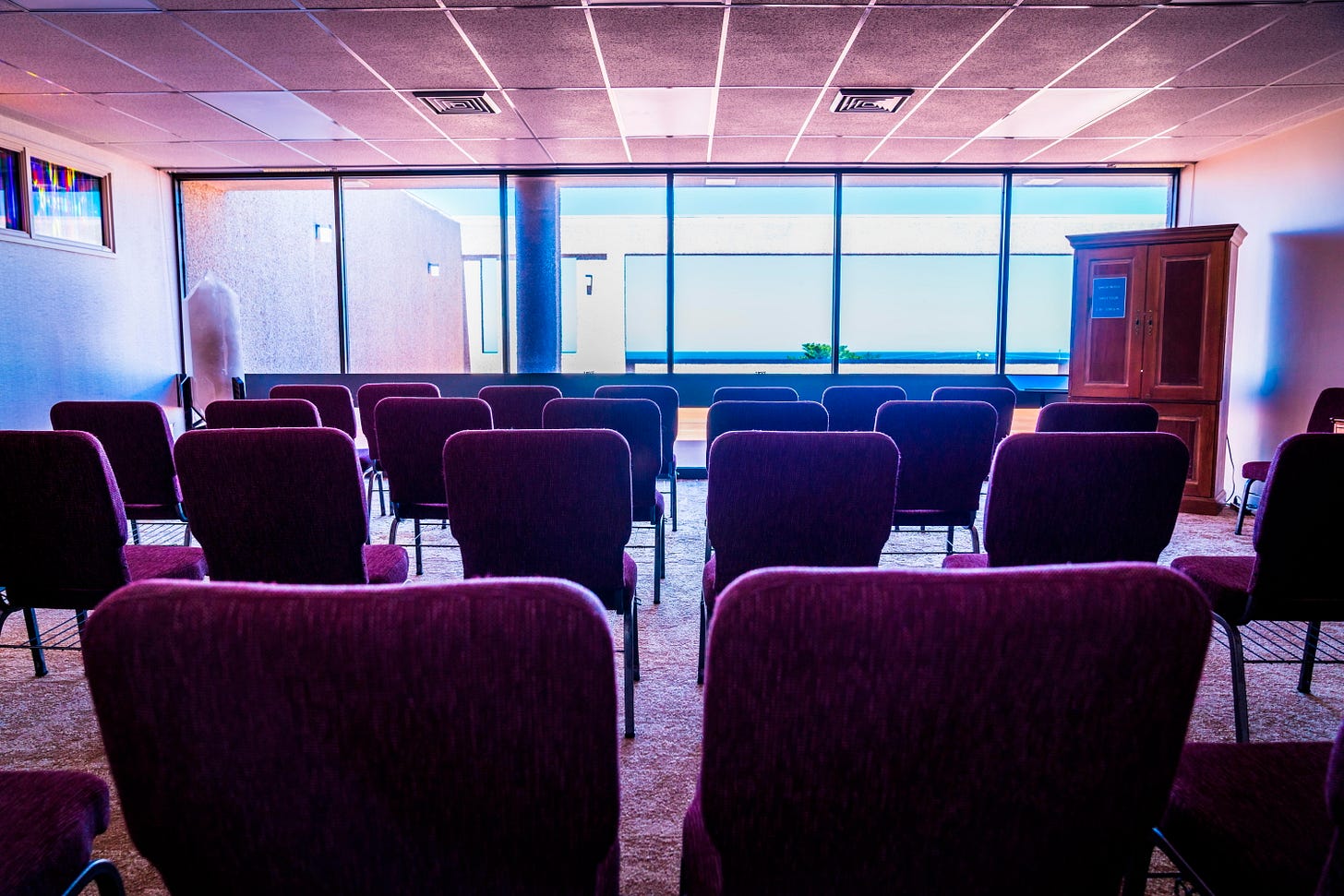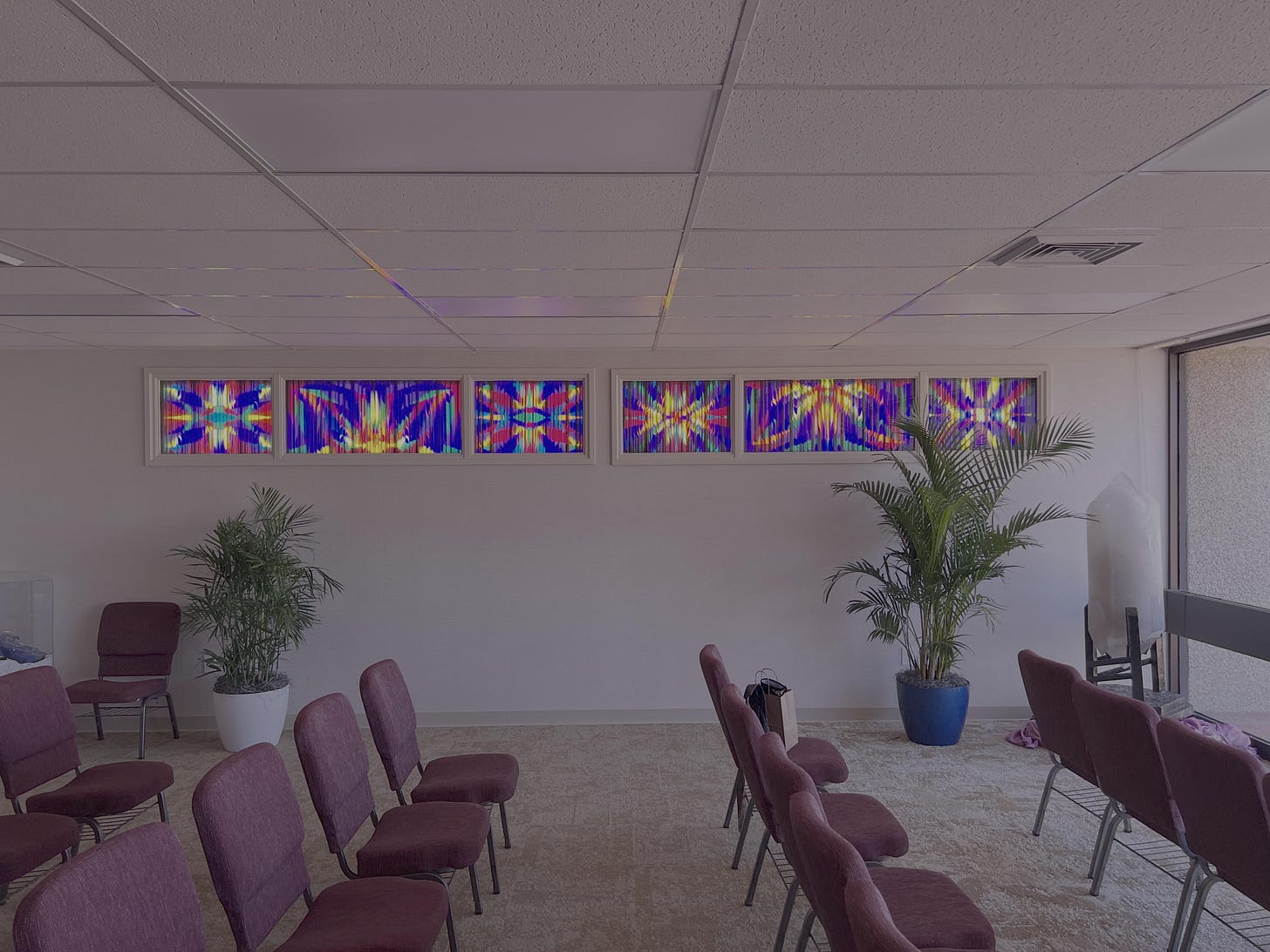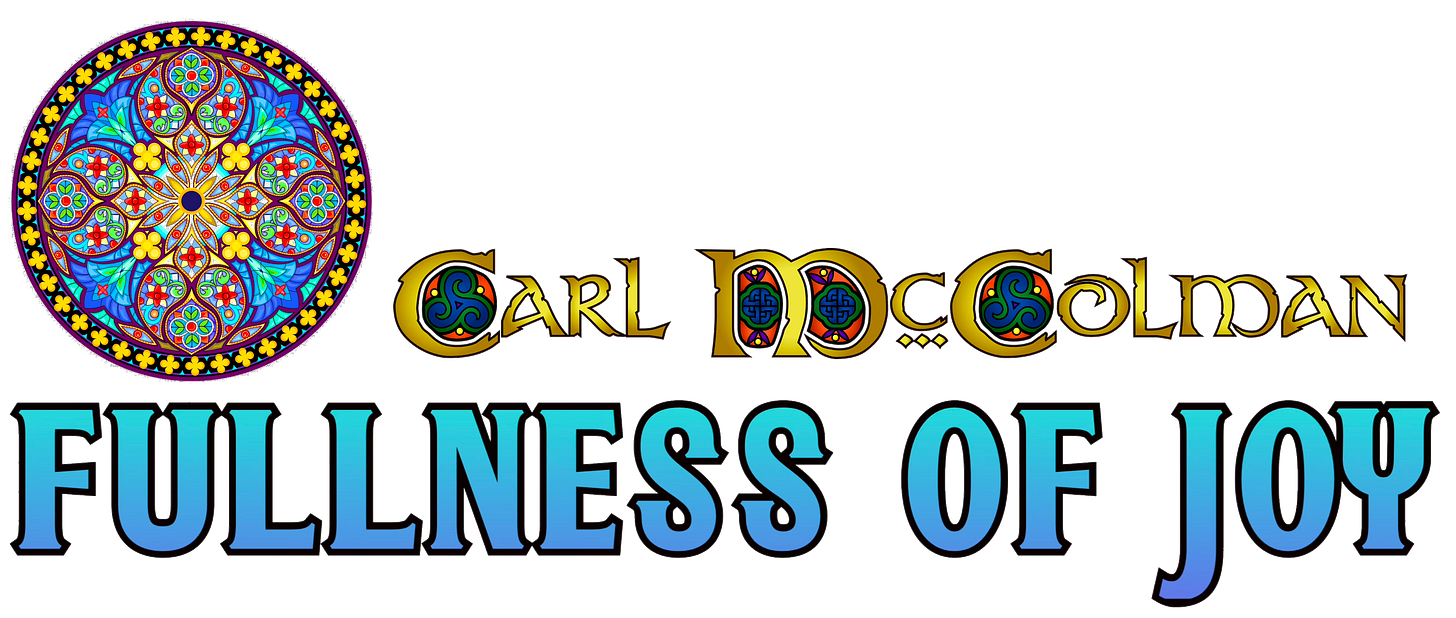A Meditation Room Selfie
Or, Why Contemplative Christianity Makes Room for an Appreciation of All Streams of Mystical Wisdom
Here is a selfie that my wife Fran and I took last month, on the occasion of our 32nd wedding anniversary. We spent the day in Virginia Beach, VA, not far from where I grew up. We were there because I was booked to speak at a church in Newport News the following Sunday. Since our anniversary was that same week, we turned what could have been a short trip for work into a mini-vacation.
While in Virginia Beach, we visited a center called the Association for Research and Enlightenment. I’ve been going there since the summer after I graduated from High School, way back in 1979. The A.R.E. has a beautiful meditation room overlooking the Atlantic Ocean, so Fran and I decided we’d enjoy bringing our daily practice to that room with its beautiful setting.
This picture was taken in that meditation room, standing next to what is probably the largest quartz crystal I have ever seen. In fact, the A.R.E. Meditation Room is chock full of amazing crystals and gemstones, including a 40-kilogram (!) specimen of lapis lazuli from the Himalayas.
It occurs to me that many readers who discovered me through my work related to Christian mysticism might be a bit surprised to see a picture of me smiling next to such an obvious symbol of, well, new age spirituality. Nothing says new age like crystals.
I thought this picture might be a fun way for me to talk a little bit about my rather nuanced relationship with spiritualities beyond the circle of Christian contemplation.
First, some backstory. The Association for Research and Enlightenment was founded in 1931 by a Christian medical clairvoyant named Edgar Cayce. This right away requires a bit of explanation, as the words “Christian” and “clairvoyant” are not often uttered in the same breath. But in his short lifetime (he died in 1945 at age 67) Edgar Cayce became renowned as a psychic who dispensed advice on health concerns but also on spiritual and metaphysical topics; meanwhile, he was also a devout Christian who taught Sunday School at his local Disciples of Christ church. Originally from Kentucky, Cayce moved to Virginia in 1931 to set up A.R.E. as a non-profit organization to promote his teaching and to carry on his work after his passing. In the 80 years since his death, the A.R.E. has continued, although ironically (or maybe not so ironically), one of the challenges the organization has faced has been the tension between Christian and new age ideas and perspectives on the part of its leadership.
My home town is about an hour from Virginia Beach; as a teenager active in the charismatic Christian community, I was warned to stay away from the A.R.E. since its ties to psychic and clairvoyant practices made it, in the eyes of Christian fundamentalists, dangerous (read: demonic). But eventually I began to question the authoritarianism and dualism of the charismatic world, so when a friend of mine invited me to go visit the A.R.E. headquarters, I decided to go check it out for myself.
While there, we attended a lecture on meditation — a topic that was new to me, but that immediately sparked my interest. Afterward, my friend suggested we go to the third floor and visit the meditation room.
I immediately fell in love with the place. The small room was oriented toward a wall of plate glass windows facing the calm expanse of the Atlantic. The room itself was quiet with the only sound coming from the steady drone of a white noise machine. On the north side, a row of colorful stained glass windows bathed the room in an array of purples and reds. Comfortable chairs faced the window, and we sat for several minutes in the silence. I did not know how to meditate, and would not learn to meditate until several years later when I was in college — and would not begin a daily practice until graduate school. But I often think that my lifelong love affair with the disciplined practice of intentional silence began, very quietly and humbly, that day in Virginia Beach, gazing out into the azure hues of the Atlantic Ocean and the clear sunlit sky.
But what about Cayce’s reputation as a psychic? A clairvoyant? What about those humongous crystals, which weren’t there in 1979 but showed up over the years that followed?
Let’s take all that one at a time.
Granted, psychics and clairvoyants typically do not find a warm welcome in Christian spaces, at least not officially. My experience is that many liberal Christians view psychic phenomena as fraudulent (regarding parapsychology as a pseudoscience), while conservative Christians denounce such phenomena as evil or demonic. As for me, my theology and spirituality certainly are more liberal in orientation, but as a student of mysticism and contemplative spirituality, I can’t help but notice how many of the mystics and contemplatives of the past (beginning with Biblical figures) exhibited behaviors that today we would describe as psychic.
Like so many of the mystics, Edgar Cayce’s message was one of personal empowerment and spiritual encouragement. In other words, he — like the mystics — proclaimed that anyone could experience a direct connection to God or the Spirit; we do not need to rely on an institution like the church or any other intermediary to conduct our business with the heavenly realm. Psychic spirituality, like mystical spirituality, is profoundly egalitarian, inclusive, and democratic. Which might very well be the real reason that Christians, whether on the left or the right, tend to be so dismissive of it.
For the record, I personally am an agnostic in regard to the claims of psychics. I think maintaining a critical mind is important, no matter where our spiritual ideas or beliefs come from. If a psychic, or a mystic, or a saint, or a theologian, or a pope, says something is true, I believe it ought to be subject to thoughtful discernment. Maybe their message is true, and maybe it’s not. Maybe what they say is spiritually nourishing, and maybe it’s not. Everything is subject to careful, prayerful, and thoughtful discernment.
With that significant caveat in mind, I am willing to entertain the idea that some people are gifted at accessing the depth of wisdom and knowledge found deep within their subconscious, or perhaps even “given” to them through the agency of an angel, a saint, or the indwelling Spirit. But fair is fair, and if we can receive spiritual guidance from an enlightened spirit, it’s also possible that we can be misled by a capricious or deceptive spirit. So once again, discernment is key.
Mystics like Teresa of Ávila and John of the Cross believed it was important to discern whether a word of guidance received mystically truly comes from God or an angel, or merely from one’s own ego, or even from an unfriendly spirit. We might be wise to continue with that line of discernment in the present.
With all this in mind, what can I say about Edgar Cayce in particular? And the short answer is, I don’t know enough about Cayce to pass judgment. According to the A.R.E., many of his medical readings were helpful to the clients who came to him. On the other hand, some of his ideas seem to be based on poor science and a naive understanding of history. For example, Cayce spoke of the lost continent of Atlantis. If anyone takes Atlantis literally, they have checked their critical thinking at the door. On the other hand, what if someone (and perhaps Cayce himself) regarded Atlantis as a mystical symbol rather than a historical reality? That, to me, seems just as acceptable as reading the Garden of Eden story or the myth of Shambhala as stories resonant with symbolic meaning.
It seems that the question we should be asking is not whether psychics are “true” or “real” or not, but rather what is the best way to reflect on their ideas and claims? If we accept their words as symbolic invitations into spiritual reflection, I’m willing to make room for them at the table.
I tend to find Edgar Cayce inspirational, less in terms of what he taught, and more simply in terms of what he represents. As a devout Christian who nevertheless embodied an appreciation for the world’s positive spiritual paths (and for the wonders of the human mind), I see Cayce as an early icon of interspiritual mysticism. In his life, he represents the invitation to go deep in one particular tradition (in his case, Christianity), while also respecting wisdom that can be found in other ways.
Like Cayce, I believe strongly in a healthy interspiritual mysticism that weaves together western, eastern, and indigenous wisdom streams: think of Christ as an icon of western wisdom, the Buddha as an icon of eastern wisdom, and crystals (or Goddess images) as icons representing indigenous or earth-based spiritualities. Other “icons” of mystical wisdom could also include the Kabbalah, the Sufis, various Hindu deities, the Tao, the Medicine Wheel, the Labyrinth… the list could go on. True mysticism makes room for all three of these streams (eastern, western, indigenous), and Cayce seems to be an inspiring figure of someone who embodied that kind of holistic mysticism in his own life and words.
Regardless of Edgar Cayce’s merits (or lack thereof), the fact remains that the association he founded now houses one of the most beautiful meditation rooms that I have ever seen. Just like you don’t have to be a fundamentalist Christian to enjoy the splendor of Chartres cathedral, if you ever visit Virginia Beach you can appreciate the silent serenity of the A.R.E. meditation room, regardless of what you may think of Edgar Cayce (or psychics in general).
Now, what about those crystals?
Many people in the new age world believe that crystals and gemstones create subtle energetic fields that make them powerful tools for spiritual healing or personal growth. Crystals are seen as having correspondences to the chakras, to elements of astrology or Kabbalah, or to other systems of magic, that give them particular qualities. People will seek out certain stones because of their reputations: rose quartz fosters love, amethyst aids in psychic protection, and so forth.
Meanwhile, plenty of people reject all this as pseudo-scientific hogwash, and others decry it as the deceptive work of malevolent spirits. Sound familiar?
It probably won’t surprise anyone to learn that I view the metaphysical claims of crystals and gemstones with plenty of skepticism — but not a cynical skepticism. I am comfortable with the scientific perspective that no evidence for the healing properties of gemstones can be documented, at least not at this time. If all else fails there’s always the placebo effect, which is to say, many people might find crystals and gemstones to be powerful conduits of spiritual growth and healing simply because they believe it to be so.
Meanwhile, there’s another factor at play: the simple fact that crystals and gemstones are beautiful. I myself have loved geological specimens ever since I was a child, long before I had ever heard of the supposed metaphysical properties of gemstones — or the arguments against such ideas. To me, crystals and gemstones stand as evidence of what a beautiful and wondrous world we live in, and I can see how the lore associated with them can be appreciated as metaphorical and mythical in nature. Can a rose quartz crystal help you to be more loving and more open to receiving love? I really don’t know (and tend to be skeptical of such claims, at least on an empirical level). But if wearing a rose quarts pendant helps you to be a bit more trusting in the idea that love can and will flow more readily into your life, I think that’s beautiful — as beautiful as the stone itself.
So when I see a collection of giant crystals like you can find in the Meditation Room at the A.R.E., I am struck by their beauty and magnificence. I don’t expect the stones to make any kind of observable, measurable difference in my life — but I’m perfectly willing to let my imagination soar with the spiritual possibilities that the lore of these amazing stones represents.
There you have it. What’s a nice Christian contemplative like me doing at a new age center like the A.R.E.? Enjoying the beautiful serenity of the meditation room, the geological beauty of the crystals, the vast wonder of the ocean, and the ever-present possibilities that the mystical life offers to all of us, all the time.
Be sure to check out my other newsletter: “The Mystical Journey,” consisting of shorter, meditative/inspirational writings. To subscribe, visit www.anamchara.net.



